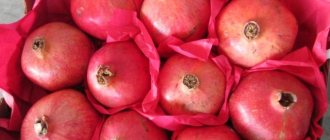Choosing a pomegranate for storage
Pomegranate is a fruit with a long shelf life. Under the right conditions, fruits can last from 2 to 9 months without losing their properties. But only if you choose them correctly in the first place. What to look for when purchasing:
- Appearance. Complete, without damage or cracks. A ripe pomegranate has a pinkish or red rind. Not faded, no dents or brown spots. The color is uniform, matte.
- Peel. Dry, if wet and elastic, then the fruit is not yet ripe. It feels slightly woody to the touch, as if it is hugging the grains.
- "Crown" and stalk. Dry, the crown is fully open, and the stalk is framed by sepals.
- Weight and size. You should choose fruits with a diameter of 8-10 cm. If the sizes are the same, you should give preference to heavier fruits (at least 450 g). This indicates their complete ripeness.
And further. If the fruit is ripe, then when you lightly press on it, you will hear a slight crunch. And when tapped, a specific sound is produced, somewhat reminiscent of a metallic ringing. In unripe fruits it is dull.
Benefits of pomegranate
Pomegranate seeds contain many vitamins: C, B6, B12, P. The concentration of microelements is also high: calcium, magnesium, potassium, manganese, phosphorus, iodine, iron, sodium.
Pomegranate juice is saturated with plant acids: citric, malic, tartaric, oxalic, succinic. Thanks to them, this fruit stimulates the appetite and helps digestion with low stomach acidity.
Pomegranate is useful for the cardiovascular system: it strengthens blood vessels, normalizes blood pressure, promotes hematopoiesis, active synthesis of hemoglobin and red blood cells. Therefore, pomegranate juice is often prescribed for B12 anemia, low hemoglobin and general weakness during the recovery period after illness and surgery. Useful for all older people as a prevention of heart and vascular diseases.
How to store
To prevent pomegranates from spoiling, they must be stored at a temperature of +1...+10 °C and moderate humidity. If the latter is high, the fruit will quickly rot, and if it is low, it will dry out. A basement or cellar or refrigerator is suitable for storage.
In the apartment
At room temperature +18...+24 °C, in relative warmth, it will not be possible to preserve pomegranates for a long time, a maximum of 7 - 10 days. Afterwards they will begin to dry.
Cut or peeled pomegranate is best consumed within 2 to 3 days. Store in the refrigerator for the entire period; at room temperature, the product will lose its properties in the first day.
In a refrigerator
In the absence of high humidity, pomegranates should be stored in the vegetable compartment of the refrigerator. In a cool, dry place, the fruit will last for 1 - 2 months.
Each fruit must be wrapped loosely in clean paper (not newspaper) or parchment. And once a week, inspect the fruits, removing spoiled ones, and replace the damp paper with new ones.
In the cellar or basement
In such storage, the temperature should also not rise above +10 °C.
Option 1. In boxes
Wrap the selected fruits in clean paper or parchment. Place them in a box in 1 - 2 layers, pre-cover the bottom with paper. Cover the top with thick cardboard or cloth. This way the fruits are stored without losing their quality for up to 2 months.
Do you always follow the correct storage of food/medicines and their product proximity?
Yes, of course, this is very important so as not to spend money on your health later.
49.12%
Not really, because there won’t be anything like going to the toilet.
26.32%
I look at it by appearance and if I use anything after heat treatment.
24.56%
Votes: 171
If the temperature conditions are observed, without changes, the box can also be kept on an insulated balcony.
Option 2. In a clay shell
Prepare a clay mash by mixing water with clay until it becomes liquid sour cream. Dip each pomegranate with a “crown” into the pulp, let it dry and place it in a row on racks (in a cardboard box or wooden box), and cover the top with a cloth. If the clay crust has not set, there are gaps, the procedure can be repeated.
In this kind of “cocoon” they can lie for up to 5–6 months. It is believed that unripe pomegranates can ripen with this storage method.
In a clay “wrapper” you can also preserve carrots or watermelons for a long time for the winter.
In the freezer
You can store pomegranate seeds for the winter in the freezer. It is not recommended to freeze whole fruits, if only because of their volume. But ripe grains in sealed packaging (preferably vacuum) can be frozen for up to 6-9 months. Although you shouldn’t keep it for as long as possible, it’s always better to update the blanks.
It is better to put it into bags in portions and defrost at room temperature.
At home, the key to successful storage of pomegranates is their periodic inspection. Spoiled fruits should be thrown away immediately and damp paper replaced in a timely manner.
You can store pomegranate seeds for the winter in the freezer. It is not recommended to freeze whole fruits, if only because of their volume. But ripe grains in sealed packaging (preferably vacuum) can be frozen for up to 6-9 months. Although you shouldn’t keep it for as long as possible, it’s always better to update the blanks.
Basic rules for storing pomegranate
So, the product was purchased according to all the rules. What to do next? To store the fruit, you need a refrigerator or basement.
At what temperature should pomegranate be stored? The ideal range is from 1 to 10 degrees. At the same time, take into account the air humidity, it should be in the range of 65-80%. This is an indicator, since if the humidity in your basement is exceeded, the fruits will begin to rot and “will not live long”; if the humidity is low, the pomegranates will begin to dry out. If the conditions are met, pomegranate can be stored for up to 5 months. By purchasing pomegranates for the winter, you will provide your family with juicy and healthy berries. Below we will consider ways to store pomegranates: refrigerator, freezer, clay shell.
Regardless of the type of storage, sort out the fruits throughout the storage period. It is possible that you did not notice the cracks or inclusions on the pomegranate, and if you do not remove such fruit from the container, it will infect others.
In a refrigerator
Storing pomegranates in the refrigerator is a solution for city residents who do not have basements. Let's figure out how long you can store pomegranates in the refrigerator, and under what conditions:
- Do not put pomegranates in plastic bags, this will lead to damage to the peel;
- for longer storage time, wrap each fruit in paper, this will protect it from excess moisture in the refrigerator;
- The bottom compartment of the refrigerator is best suited for storage, as this is usually the most optimal temperature.
How to choose the right pomegranate when buying (signs of a ripe and sweet pomegranate)
Ripe pomegranates are not only very tasty and sweet, but also healthier, which is why it is so important to know how to choose them in the market and store. To make the right choice and not buy an unripe fruit, you need to know just a few useful tips and the differences between ripe fruits and “green” ones:
- Appearance and color of garnet. A ripe sweet pomegranate should not have a fleshy, smooth and shiny surface (peel, rind) - this is a sign of an unripe and sour fruit. A ripe pomegranate fruit has a slightly rough, thin and dry skin, but it fits tightly to the grains. The color of the pomegranate should be pinkish (reddish), but not light brown or with an orange tint - this is a sign that the pomegranate is spoiled and has begun to rot.
- When choosing a pomegranate, pay attention to its corolla (a kind of crown at the base left over from the flower); it should be dry (completely dried out), without any green sprouts.
- A ripe pomegranate should feel firm to the touch and have a ribbed structure (not uniformly round). If the fruit is soft, it means it has begun to deteriorate, was not stored correctly or was frozen during storage or transportation, therefore it will be of poorer quality.
- When choosing between several pomegranate fruits of the same size and similar in appearance, it is better to give preference to the heavier one, since it will be more juicy (it will not dry out so much during transportation and storage).
- The grains inside a sweet and ripe pomegranate should have a rich, dark purple color. Pink and light grains are a sign of unripe fruit.
An interesting fact about pomegranate: the healthiest pomegranate fruits are grown in Turkey, as they have an optimal ratio of sugar and acids, which has a better effect on its beneficial and medicinal properties for the human body.
Is it possible to eat unripe pomegranate?
You can eat unripe pomegranate, but in small quantities, and you won’t get pleasure from it, since it will be very sour. It is always better to eat only ripe pomegranate fruits, as unripe ones can cause stomach upset (due to the high acid content in pomegranate seeds).
Can pomegranate ripen at home?
Unfortunately, an unripe pomegranate will not ripen at home. Pomegranates must ripen on the tree; if it is picked ahead of time, it will remain almost the same, which is why it is so important to be able to choose the right pomegranate when purchasing.
How to quickly peel a pomegranate
There are several simple ways to properly peel a pomegranate in order to get whole grains and not be completely splashed in pomegranate juice, which is difficult to wash off. You will need a sharp knife and just a couple of minutes of time:
- Carefully cut off the peel at the top “tail” of the pomegranate (circular cut).
- We make cuts in the peel (along the “sharp” corners of the pomegranate).
- We divide it into slices and clean out the grains.
In conclusion, it can be noted that all pomegranate lovers must learn how to choose good fruits correctly, since an unripe pomegranate will not ripen in your home and will have an unpleasant sour taste. We leave our useful tips and reviews on how to choose a ripe pomegranate when purchasing, as well as how to quickly peel a pomegranate without unnecessary problems, in the comments to the article and share it on social networks if it was useful to you.
You can eat unripe pomegranate, but in small quantities, and you won’t get pleasure from it, since it will be very sour. It is always better to eat only ripe pomegranate fruits, as unripe ones can cause stomach upset (due to the high acid content in pomegranate seeds).
Is it possible to ripen pomegranate at home?
No matter how much you would like, pomegranate will not be able to ripen or ripen at home under any circumstances. The berries ripen exclusively on trees. If gardeners rushed to harvest for commercial purposes and picked unripe fruits, then they will end up on store shelves.
Therefore, read the rules for choosing the right pomegranate again. Consume only ripe fruits, especially in the winter and spring months, this will protect you from colds and normalize the functioning of the digestive system.
What to do with unripe pomegranate
Pomegranate contains a huge amount of useful microelements and fiber. Nutritionists advise both men and women, and children over three years old to eat it. But it is not recommended to give pomegranate juice to children under three years of age - it irritates the delicate gastric mucosa and can cause allergies. Older children should be offered pomegranate juice diluted with still water.
With regular consumption of pomegranates, immunity increases, and the blood is enriched with iron - an essential trace element, the lack of which leads to anemia.
2 About color and crown
The color of a ripe pomegranate is brown-red. There are fruits of bright crimson color, sometimes orange-red, pale pink and even white. It all depends on the variety and time of ripening of pomegranates.
An unripe pomegranate has a green peel that is hard to the touch. The top of the pomegranates is topped with a flower cup that resembles a royal crown. The taste of the fruit depends on its color and condition. In ripe pomegranates, this very calyx is dry, with a color that matches the shade of the fruit. A green, slightly shriveled tail indicates that the fruit has not yet ripened and is not worth buying.
3 The main thing is taste and skin
Faceted grains that glow from the inside with a ruby color are not always an indicator of excellent taste. So at the market you should not refuse the seller’s offer to taste the pomegranate.
The skin of a high-quality fruit is thin, dry and tightly covers the grains. If the skin looks too dry, then there is a high risk of purchasing last year’s pomegranates with tasteless grains without juice.
Touch the pomegranate with your hand. If the skin is slightly rough, then feel free to buy it. A smooth, as if wet skin may indicate that the fruit was picked from the tree unripe, it simply did not have time to be saturated with juices.
How to quickly peel a pomegranate
Before squeezing juice, the fruit must be peeled. In some cases, you will need to not only remove the peel, but also separate the grains, removing all the membranes. There is a quick way to do this without much effort. Before you start separating pomegranate seeds, you will need to put on an apron or change into old clothes that do not need to be protected. This is due to the fact that when the fruit is cut, bright juice will certainly splash out, the pigments of which are difficult to remove from most surfaces.
After a little preparation, you need to start the cleaning process:
- Cut the pomegranate into quarters. This slicing facilitates access to all grains covered with internal membranes.
- Fill a large, deep bowl in which you can place the pomegranate quarters not too compactly with cold water, leaving enough free space at the top to allow you to dip your hands into the container without allowing the water to overflow.
- Place the quartered pomegranate there and separate the grains in the water using your fingers. This is the easiest way to remove the membranes, since separation will occur due to the difference in weight of the fruit parts. If desired, you can also remove the peel by manually removing it from each quarter of the fruit before dipping it into water. However, separating the grains from it under water reduces the risk of contamination of the countertop and surrounding surfaces (for example, as a result of a piece of fruit accidentally slipping and falling from your hands).
- The pomegranate seeds will sink to the bottom and the membranes will rise to the surface of the water. They should be removed with your hands or a small strainer, then remove the grains from the bottom of the bowl in the same way.
How to choose a ripe pomegranate without cutting it
To identify a ripe specimen, it is not necessary to cut the fruits. You need to figure out how to choose the right pomegranates without compromising the integrity of the peel. This is determined by several criteria.
By appearance of the berries
Basic markers that help you select ripe fruits:
- Peel. Ripe specimens of different varieties or from different countries have different colors. Classic deep pinks and reds are complemented by reddish-brown, soft green or yellowish shades. In any case, the background of high-quality ripe specimens is distinguished by uniformity, uniformity and lack of spotting. Brown, brown spots are a sign of rot in the fruit. The skin of a ripe fruit is dry, matte and dense, reminiscent of the bark of a young tree. It looks as if it is stretched: the relief of the grains appears through it. The moisture and elasticity of the peel indicate that the fruit was picked unripe, it was ripened artificially.
- Top of the head. A ripe berry has a lid on the top that is open and dry. Immature ones are green.
- Pedicel. If it has been preserved, then you need to select specimens with dried, framed by dry sepals. Green, with wet or rotten fragments - defective.
If the fruits received are unripe, but without signs of spoilage, you need to let them rest.
Good fruits are free from dents or cracks.
By weight of pomegranate
The question of how to determine the ripeness of a pomegranate can be solved by its mass. For exotics, the rule works: the larger the fruit, the better. The minimum diameter of a high-quality fruit is 8-9 cm. If possible, take specimens from 10 cm. If they are ripe, they will weigh half a kilo. With equal sizes, it is better to choose a heavier specimen: this pomegranate is tastier and juicier. This is the highest quality option. In large but light fruits, the process of grain drying has begun. They don't have enough juice.
By sound
Ripe pomegranate is easy to select as follows:
- lightly squeeze: in a ripened specimen, the grains crunch;
- when tapped, the ripe fruit produces a ringing, “metallic” sound;
- An unripe pomegranate gives itself away with a dull sound.
Whether it is possible to eat unripe pomegranates is up to everyone to decide for themselves. This is not fatal, but unpleasant consequences are possible. It all depends on the degree of immaturity (great or not) of the fruit and the characteristics of the body. Their taste is also not for everyone.
The most delicious varieties of pomegranate
Experts divide pomegranate varieties into 2 groups: those with soft and hard seeds. The former are very demanding to grow and are not suitable for central Russia. The second group consists of fruits with hard seeds and juicy grains - they can be grown in the Moscow region.
In Russia, only pomegranates with hard seeds are grown
The protective skin of the berry can be of various shades - from light pink to dark crimson. But a whitish color does not mean that the fruit is not ripe, but only indicates its varietal characteristics. To choose a pomegranate based on taste, you first need to know the most popular varieties that you can find in stores and on the market.
Ak-Don Crimean
The fruits are large, oval in shape, with thin pink skin with red spots. The grains are light pink, the pulp is sour.
Dona Crimean - a common variety of pink pomegranate
Dogwood anor
Uzbek early ripening variety with pink-scarlet skin. The grains are bright red in color with a sweet and sour taste.
Bala mursal
The fruit is medium-sized, flattened, with red-raspberry grains, very sweet and aromatic, the sourness is barely noticeable. The homeland of the variety is Azerbaijan.
The sweetest variety of pomegranate is Bala Mursal.
Nikitsky early
Very large fruits with a high neck and a large cup, with a medium-thick red skin. Dark cherry grains of small sizes. The taste is sweet and sour.
Cossack improved
The fruits are large, round in shape, with a creamy-green skin on the outside and yellowish on the inside, with an uneven color over the entire surface.
Soft, green or damaged fruit will not be tasty - you will have to taste the acid, not the desired sweetness. When choosing a delicious pomegranate, consider the above. At the same time, give preference to shipments that were delivered from nearby countries - Uzbekistan or Turkey. The latter country offers customers not only the classic ruby variety, but also a white variety, which contains more vitamins than an apple, and is light and sweet inside. Take the Turkish pomegranate - it is tastier and thicker than its Uzbek “brother”, it starts to sing faster.
Ways to preserve the harvest until spring
The problem of how to store pomegranate at home can be solved. The fruit is an inhabitant of the subtropics, so you need to create a “native”, soft regime for it.
Refrigerator storage
You can choose this storage method if the refrigerator provides a positive temperature (2-9°C) and a humidity of 70-75%:
- Washed and dried ripe specimens should be placed in the “fruit” compartment. Under-dried pomegranates will begin to mold.
- Each fruit is wrapped in parchment paper - freshness will last longer. Plastic bags, even unsealed, are not suitable. During storage, moisture will still appear inside and the pomegranates will spoil.
- The presence of “neighbors,” including vegetables, does not affect the condition of exotics.
Freezer
This method is suitable if you need to maximize the shelf life of fruits. The freezer will preserve their condition from several months to a year. However, you should not freeze ripe pomegranates entirely:
- the fruits are bulky and “steal” a lot of space;
- cleaning takes a long time and is troublesome;
- When defrosting, due to temperature changes and skin pressure, the grains burst and the juice flows out.
It is worth choosing a different method. The fruit is cleaned, the grains are sorted, removing spoiled or suspicious ones (this is indicated by the color of the grains). The remaining berries are rinsed, dried, placed in a bag or plastic container, and stored in the freezer.
The disadvantage of freezing is the partial loss of vitamins from pomegranate. But you don’t need to clean anything; the bag or container takes up less space. And this is the only way to preserve berries if ripe fruits begin to rot.
Some housewives advise choosing vacuum bags for storing frozen grains.
Clay for preserving fruits
If there is no refrigerator or basement, fruits are stored in a heated apartment. Regular clay will help. It is better to choose a white variety from a pharmacy or hardware supermarket:
- Since we are talking about food, it needs to be heated (in the oven or over a fire).
- Then the clay is diluted with warm water to the consistency of sour cream.
- Washed and dried fruits are immersed in the clay mixture with the upper part (where the crown is), removed and left to dry. If the clay “cocoon” is thin, the procedure must be repeated the next day.
- When the second layer dries, the mixture is poured over the “crowns” of the fruit.
- Dried pomegranates are stored in a box, box or on a shelf. Cover with natural fabric or cardboard.
In the clay “cocoon” only the pomegranate skin dries out. The juiciness and aroma of the grains and other beneficial properties of the fruit are preserved. In a moderately dry room it will last up to six months. This method should be chosen for storing unripe pomegranates (they will gradually ripen). But the fruits need to be whole: they should not have cracks, dents, or other damage.
Cellar
It is better to allocate a dry, cool underground floor in the house for storing pomegranates. Humidity, temperature and shelf life are similar to refrigerator. Every six months, the fruit in the cellar is “inspected” for spoilage or other problems. Fruits that have begun to rot must be separated from the rest so that the spoilage does not spread to them. In the cellar, pomegranates are laid out on shelves or placed in boxes in one layer, spaciously, with gaps between the fruits.
Balcony, loggia
If the climate or microclimate allows, it is rational to choose a balcony or loggia for storing ripe exotics. Suitable containers for containers are boxes or boxes:
- the bottom of the container is lined with hygroscopic (moisture-absorbing) fabric;
- each fruit must be wrapped in paper (plain or parchment);
- Laying in only one or two layers is allowed: pomegranates piled on top of each other will burst;
- The top of the fruit is covered with cardboard or other light-proof material.
Under such conditions, ripe pomegranate is stored for a couple of months.
How to extract juice using a juicer
There are several types of juicers, each with their own pros and cons. However, any of them will be more convenient and practical compared to using improvised items.
Manual juicer
The simple process of squeezing juice from orange halves is known to everyone. Similarly, you can easily extract the juice from pomegranate using a manual juicer.
To do this you will need to complete the following steps:
- Cut the pomegranate in half crosswise down the middle (not lengthwise from the top to the stem), and place a glass or small bowl under the juicer cone on the countertop to catch the juice that will flow from the fruit.
- Raise the juicer handle up, place the fruit halves flat side down on a special stainless steel cone and pull the handle down. The container, attached to the lowering handle, follows the curve of the back of the fruit.
- Press with moderate force and watch the juice flow out of the pomegranate. It is advisable to repeat this step several times to extract maximum juice, and remove the squeezed fruit halves.
- Strain the finished juice through a strainer to remove any pieces of pomegranate seeds that may have gotten into it, and serve immediately, or refrigerate (or even freeze). When squeezing a large amount of fruit, you need to collect a large amount of juice in a jar.
To ensure that the pomegranate juice obtained using a manual juicer is always of high quality, it is recommended to use the following tips:
- A manual juice press consists of only 3 parts - a basket, a cone and the pressing mechanism itself. After completing each preparation, wash them with a mixture of dishwashing detergent and warm water and dry them thoroughly, especially metal parts.
- It is recommended to lubricate the moving parts of the mechanism (handles) with a small amount of vegetable oil before the first use and after each subsequent use to ensure smooth operation of the juicer.
- Most manual juicer models come with two wrenches for adjusting the pressure on the handle and mounting bolts. Therefore, you can make the press more powerful if the juice is difficult to squeeze out, despite the applied efforts.
- You should always wash fresh fruit before pressing.
- The juicer basket needs to be constantly cleared of stuck pomegranate pieces so that the juice flows freely.
- To extend the shelf life of freshly squeezed juice, you can do “flash pasteurization” - heat it to a temperature below boiling and quickly cool it with ice.
Mechanical juicer
You can squeeze juice from pomegranate using either a vertical or horizontal juicer. The disadvantage of this method is that it requires pre-cleaning the pomegranate seeds, which can take several minutes per fruit. When squeezing juice from a large batch of fruit, this will significantly slow down the work.
The advantage of using a mechanical juicer is that the juice is squeezed out of the beans without the skins and membranes getting in, and as a result has a sweeter taste (compared to a manual press). Another advantage is a higher juice yield, since the mechanism of the device squeezes the grains almost dry.
The process of squeezing juice in a mechanical device is performed as follows:
- It is necessary to cut off the top of the pomegranate and cut it lengthwise in parallel lines. The inside of the fruit is divided into parts like orange slices by a white membrane. It is the areas where it grows together with the peel that should be used as a visual guide when making cuts.
- The fruit must be divided along the cuts, tear off the slices from each other, dip them one by one in a bowl of cold water and use your fingers to tear off all the grains from them, separating them. If individual grains are firmly attached to the membrane and do not separate, you can scrape them off with a knife.
- All pieces of membranes and peels should be removed from the surface of the water, drained through a colander, sorted through the grains for any foreign particles that have accidentally fallen into them, place them in the loading tray of the juicer and continue preparing the juice, based on the instructions in the instructions for using the device (this depends on models and designs).
Electric juicer
Pomegranates are hard-shelled fruits filled with hundreds of small red pearly seeds. Only they are suitable for eating and making juice. Therefore, it is recommended to squeeze pomegranate juice manually. An electric juicer is also suitable, but you will need to completely separate all the grains from the white membrane (as with a mechanical device).
The advantage in this method can only be the presence of a filter that allows you to obtain juice without pulp and seeds:
- Pour the peeled pomegranate seeds into the basket of an electric juicer and extract the juice according to the instructions in the manual compiled for your specific model.
- Using a filter, strain the juice and pour into a mug or pan, serve or refrigerate.
How to select and store pomegranate: general rules
The choice and method of storing pomegranates is determined by the variety, degree of ripeness and initial conditions of the fruit. General principles to consider:
- To store for the winter, you need to select only selected ones - undamaged, dry, “woody” specimens.
- Fruits with a soft or moist crust are pre-dried.
- Optimal storage conditions for exotics: temperature above zero, maximum 10°C, humidity 60-70%. Illumination and humidity when storing fruits should be selected at medium levels. In twilight, pomegranates feel more comfortable than in bright light or pitch darkness. At high humidity they will rot, at low humidity they will dry out.
- To store fruits in the basement, apartment, or on the balcony, wooden, cardboard or plastic containers are used. You should choose not a “solid” one, but a ventilated one, with holes.
- It is necessary to regularly inspect the backing of the container: if it becomes moist or looks suspicious, replace it with a new one.
- Each fruit is wrapped in paper. It is better to choose regular or baking parchment. They will absorb excess moisture. Sheets with printing ink (newspaper or magazine gloss) are not suitable: the ink will saturate the peel.
- The stock must be sorted regularly, removing spoiled specimens. Otherwise, the “epidemic” will affect other fruits. Selected spoiled pomegranates are processed immediately, separating the grains suitable for consumption from the total mass.
- If only the peel is spoiled, the grains are reconsidered and filled into a plastic bag or plastic container. The container must be closed and placed in the freezer. Quick-frozen ripe grains can be stored for up to a year.
The shelf life is affected by the type of pomegranate. Sour specimens should be chosen if they are to be stored for 8-9 months. Sweet pomegranate remains fresh for six months.
Conclusion
Supermarkets or markets sell pomegranates even in cold weather. But interruptions happen. In order not to take risks, it is wise to stock up on ripe exotics at least for the duration of the cold weather. Especially New Year and Christmas holidays.
For purchasing for long-term storage, it is better to choose the second half of November. This is the harvest season from Azerbaijan and other traditional suppliers - Central Asian countries. From there, transportation does not take much time, so the quality of the fruit is excellent.
If the climate or microclimate allows, it is rational to choose a balcony or loggia for storing ripe exotics. Suitable containers for containers are boxes or boxes:
https://infoeda.com/kak-vybrat-granat-spelyj-sochnyj-i-sladkij.htmlhttps://korzinka.riamo.ru/article/kak-vybrat-granat-rekomendatsii-i-lajfhaki-1365https:// forum.cofe.ru/showthread.php?t=133405https://fructberry.ru/frukty/kak-vybrat-i-xranit-granat










